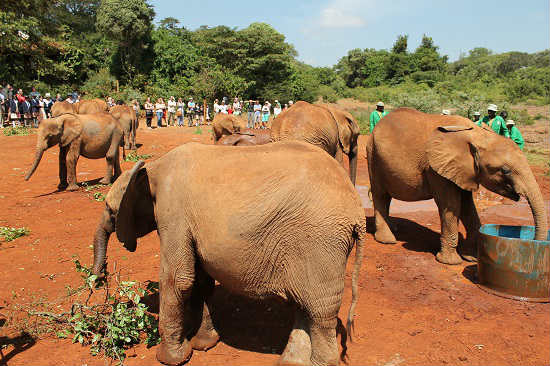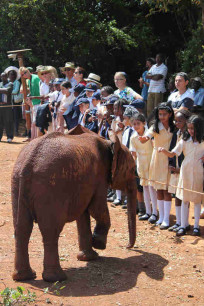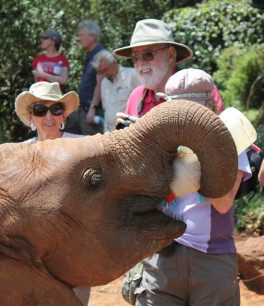

Slowly, one by one, the young elephants come out of the bush in a single file, trotting and trumpeting, following their keepers, and eager to interact with their daily visitors.
This is the start of another day at the David Sheldrick Wildlife Trust and elephant rescue center in Nairobi, Kenya, where orphaned elephants can be viewed up close by the public and where they are not just sheltered, but lovingly cared for and eventually returned to the wild.
This unique rehabilitation and educational center began as the passionate project of Dame Daphne Sheldrick, the widow of David Sheldrick who was the original warden of Tsavo game park in Kenya, where after his two decade career there ended, had made it the largest single game park in the country and the only one capable of supporting large herds of wild elephants. Dr. Sheldrick founded the center in 1977 and it remains a pioneer in one-on-one human care for orphaned animals with the intent of returning them to their native habitat.

Most of the animals at the center were orphaned by poachers and the David Sheldrick Wildlife Trust is leading the way to put an end to this despicable crime. They consider education to be a prime factor in stopping poaching and offering a personal glimpse into the lives of these animals, seeing them up close and realizing their intelligence and love is the first step. There simply is no way to put into words the experience of looking this animal in the eye and knowing that your presence is assisting in returning it to its natural state.
As one of the most intelligent animals, an orphaned elephant is much like a human baby, emotional and sensitive and endures a period of mourning upon losing its parents. Once it arrives at the Sheldrick center human keepers will tend to the infant around the clock, sleeping in the stall with it, feeding it, making sure it is warm and offering an unconditional love that these highly social creatures return. More than any other animal, elephants are part of a close knit, extended family unit and need this love and support more than ever when orphaned. However, the keepers rotate every few hours to make sure a baby does not become unusually attached to one particular person which would make it difficult when it is time to return to the bush.
Since these fast growing infants require a lot of milk and it is impossible to milk wild elephants to feed them, the center, along with Wyeth Laboratories SMA, have developed a formula rich in Calcium, Magnesium, Vitamin C, Emulsified vegetables, and as the animal grows, later on coconut and oatmeal porridge are added. This is fed to the infants by large baby bottles with nipples. These elephants that come into the world weighing less than 200 pounds gain up to two pounds of weight daily on this formula.

The center opens daily for only one hour, from 11 a.m. till noon, during which time visitors are only separated from the elephants by single rope fence that the youngsters delight in playing with or simply ramming on through it to be petted by a willing public. While the young pachyderms roll in the mud and love spraying the crowd with water from the pond, a senior keeper will address the crowd, answering questions and imparting useful knowledge about their charges. Just watch out for your cameras whenever a playful trunk full of water comes your way.
These young critters love human touch and return it in kind running their trunks all over you to “see” you and get your scent. They also play like puppies with each other and the public. They do not realize their own strength, so beware when one comes barreling at you at top speed; the rope will not stop it! This traveler was knocked right over by a rambunctious baby and loved having it happen!
The more people yell and cheer the more the baby’s respond, running this way and that, splashing mud everywhere and often raising their tiny trunks to trumpet a loud hello.
There is always a wheelbarrow full of formula in large baby bottles available in the compound and if the young elephants need a quick snack, they often help themselves, using their trunk to hold the bottle while they drink unassisted. After about 20 minutes with the crowd, one of the keepers will slowly make his way back to the holding area and all the juveniles will dutifully follow. Then after a quick intermission a group of older and larger elephants will be brought in the same way. Some of these have tusks and so they are kept separate from the younger ones. And just for those who may be curious, the elephant’s tusks are actually elongated incisors, no different from the rest of their teeth and they are so long that one-third of their length is underneath the gums. Also, both male and female African elephants have tusks, unlike Asian elephants where only certain males grow tusks.
If you book reservations in advance, there is a private interaction session available subject to availability from 3 p.m. till 3:30 p.m. out in the bush with the keepers and orphans. Those with active fostering of one or more orphans may, by appointment, come to the foster parent visit at 5 p.m. This is when the elephants return to their stockades for the night and visitors are able to see the orphans settling down to sleep. There is no place else where you can get so close to an elephant.
If You Go
You can sponsor an elephant through donations and if you wish to visit the David Sheldrick Wildlife Trust while in Nairobi their email, is [email protected] and the phone number is +254 (0) 202-301-396. Box 15555 Mbagathi, DO503, Nairobi, Kenya. The center is about a 45 minute drive from downtown Nairobi.
United States information: [email protected], telephone, (317) 610-3245.
- 12 Cool Things to Do in Tbilisi, Georgia’s Vibrant Capital - April 29, 2024
- Travel Guide to Spain - April 28, 2024
- Travel Guide to Scotland - April 28, 2024
